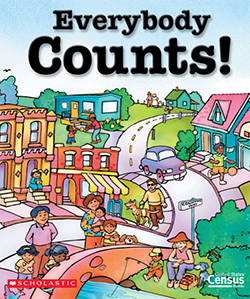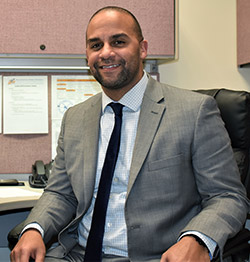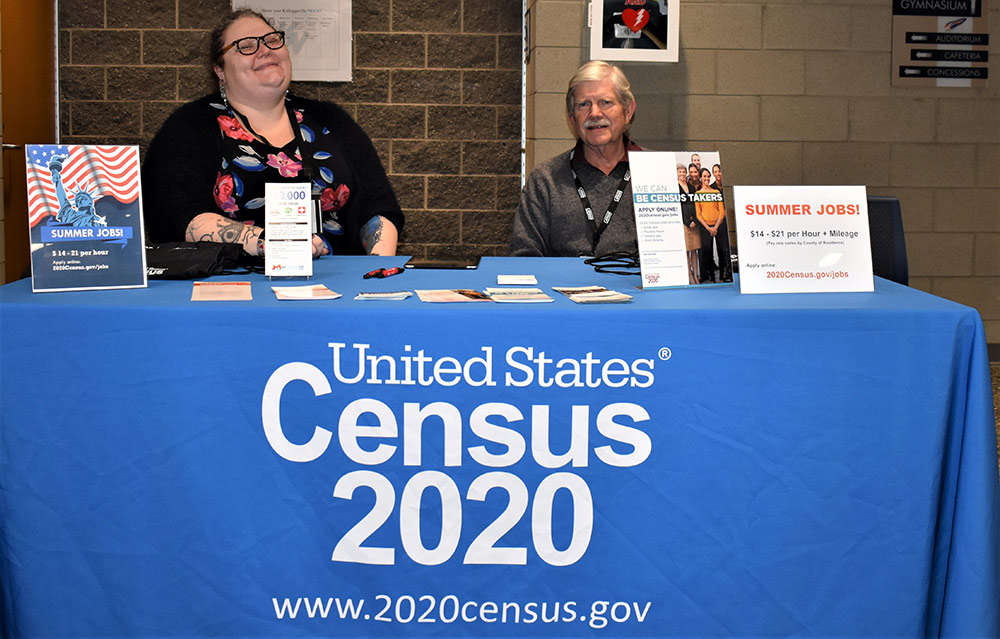How extensive is the every-decade effort to count how many people live in the U.S.?
Consider this: Though most households will get their census forms in mid-March, the 2020 Census actually launched in mid-January in Toksook Bay, Alaska, approximate population 600-700 people. Why there? Because in January, local census takers can traverse still-frozen ground as they work to get to remote areas.
So it should come as no surprise that in a slightly less frozen West Michigan, the census is also leaving very little to chance as it works to get the word out. That word is the importance of the 2020 effort to count the number of people living in the U.S. The Census Bureau’s communications campaign to increase awareness and participation in the 2020 census comes with a $500 million budget. And that communications campaign includes partnering with and providing resources for local schools.

Did You Know? The census is technically called the decennial census because it takes place every 10 years.
From Stats in Schools to A Special Song
On “Why 2020 Matters for Schools,” the Census Bureau outlines a raft of reasons schools might want to get on board with the census. This includes funds for special education, Head Start, after-school programs, classroom technology, food assistance (free and reduced-price school lunches), maternal and child health programs and more.
The site also includes resources schools can incorporate into the classroom: everything from Statistics in Schools activities and lesson plans to a coloring book for younger students called “Everybody Counts” and a complementary four-verse-and-a-chorus ditty called “Everyone Counts” that begins:
The Census counts people
In homes big and small.
You count if you’re tiny.
You count if you’re tall.
Local schools are singing along, recognizing that there’s a lot on the line for their communities when it comes to the census, required by the U.S. Constitution. In fact, the estimate is that each person counted, or not counted, means about $1,800 per year to a local community, and $18,000 over the 10-year-period between each decennial census.
This means a lot of funding is on the line with each person. Ultimately the census determines the allocation of federal funds to the tune of some $675 billion, including schools, roads, health clinics and more.

GRPS and Kelloggsville Among Local Districts Spreading the Word
John Helmholdt, communications director for Grand Rapids Public Schools, says that being asked to spread the census message is a great opportunity for most schools, and he believes they play a critical role in West Michigan as the census works to increase participation (in 2010, the response rate in Michigan was 78%).
“It’s all about trust,” Helmholdt says. “Many people don’t understand the importance of the census to local communities or local schools. Or they might be afraid to participate. There’s a lot of fear out there right now, including fear of providing information to the federal government.”
“So schools, as trusted leaders in the lives of individuals and communities, have an opportunity to educate, educate, educate. We’re trying to let people know that one of the best ways parents can support their children’s education is to fill out the census,” he explains.
Helmholdt is on the Grand Rapids Complete Count Committee, chaired by Kathi Harris, the city census coordinator. The City Commission and City Manager allocated $100,000 to help inform the community and motivate residents to participate in the count with schools being a key audience for that information.
Eric Alcorn, auxiliary services director for Kelloggsville Public Schools, agrees schools have an important role.
He met with local Census Bureau officials last fall to begin conversations about how Kelloggsville schools could get the word out to its students and their families.
“It’s important all the way around,” he says. “We’re part of this community. Parents rely on school for a lot of different things and information like this is part of it. We also hope we can ease the minds of people who worry about the census for different reasons, including privacy.”

Ad Campaign Aims to Quell Privacy Fears
Privacy concerns around the census took on a more urgent focus when U.S. Secretary of Commerce Wilbur Ross announced plans in 2018 for a citizenship status question on the 2020 census. The courts quashed that idea – there is no citizen question on the 2020 census. But in some communities, Helmholdt notes, just the idea of a citizen question amplified worries about filling out the census.
As a result, the Census Bureau put together a website called “Fighting 2020 Census Rumors” and also has unveiled a variety of ads, including spots aimed specifically at Latinos, intended to allay lingering fears about the upcoming census. One ad, called “Dinner With Friends,” includes this pointed bit of dialogue:
JUAN: Listen… I saw that at home they’re considering filling out the census, but isn’t it dangerous?
LUIS: Not at all! I was just like you ten years ago. I filled it out and look at me, I’m still here.
PEDRO: Your personal information can’t be shared with ICE nor with the police. Don’t worry.
JUAN: Well, that’s good! Right?
Kelloggsville’s Alcorn hopes the ad campaign helps, but in the meantime his district continues to do its part to get the word out and assuage fears. Local census people have passed out brochures at Kelloggsville athletic contests and have had a presence at the district’s always-popular Family Nights.
The district has communicated about the importance of the census via its website, social media and email blasts. GRPS took similar actions, with census messages going out on email, social media, text messages and letters home with students, plus several in-person appearances by census officials at GRPS schools during February and March.
“It’s all about getting the awareness out there,” Kellogsville’s Alcorn says. “It’s only done every 10 years, so the more accurate the count the better the funding.”

$1,800 Per Person Adds Up for Schools
Both Helmholdt and Alcorn point to the $1,800 per person per year figure as a big motivator for why schools should be spreading the word regarding the 2020 census.
According to the U.S. Census Bureau, about 1 million children under the age of 5 were missed in the 2010 census, and the worry is that young children are at risk of being missed in the 2020 Census, especially children who live with extended families or children who are part of situations such as multiple families under one roof.
Helmholdt says that schools end up being a significant recipient of census-based dollars, trailing only healthcare and nutrition on the list of beneficiaries. And nutrition dollars, he notes, also go to schools. Indeed, GRPS after-school programs are all federally funded and every GRPS student gets free breakfast and lunch.
As a result, Helmholdt says: “Schools have a significant vested interest in the census numbers being right.”
Or, in the words of the “Everybody Counts” chorus:
Because everyone counts
In the U.S. of A.
Everyone counts
In their own special way.
CONNECT
The Official 2020 Census Questionnaire
The Be Counted Campaign from the West Michigan Research Network









